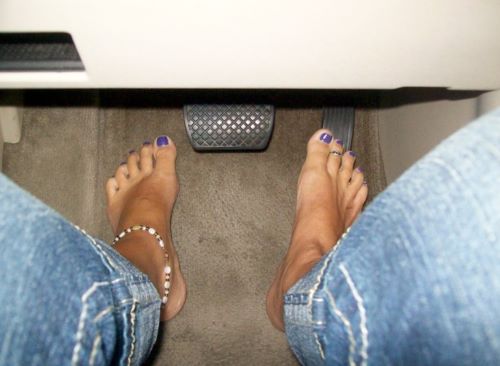

There’s an old myth you may have heard – it’s illegal to drive barefoot in California.
It’s a myth that many believe, even people in other states, but it’s also a myth that has no substance. The reality is that you can drive barefoot in California if you want. However, it’s not the best idea in the world, as driving barefoot comes with several risks that could increase the chances of an accident occurring.
Keep reading to learn more about how going barefoot puts you (and others in danger), as well as the specific legalities of driving without shoes.
What Does the Law Say About Barefoot Driving?
In a word – nothing.
Or, at least, California state law doesn’t explicitly address the issue of driving barefoot, instead focusing on how drivers have a duty of care to operate their vehicles safely. Interestingly, this lack of direct discussion of the barefoot issue means it’s also legal to ride a motorcycle without shoes.
So, in a direct legal sense, you can’t be prosecuted for driving barefoot in California. But that doesn’t mean you should throw your shoes away and take advantage of the situation. There are several reasons why driving barefoot is a bad idea and, in some cases, those reasons can lead to you facing a sticky legal situation.
Reason 1 – Bare Feet Slide More
Most car pedals are designed to offer some grip, ensuring your foot stays on the intended pedal without slipping. Combine that with the grip offered by the sole of a shoe and your foot will rarely slip from the pedal when you’re braking or accelerating.
But if you take away the shoe, you lose the sole and you’re left with your bare foot. Bare feet slip more easily, especially when wet. If you’ve just gotten in the car after taking a barefoot walk through dew-soaked grass, for instance, you’re creating a situation where you soak your pedals and increase the likelihood of slipping.
Slips spell problems.
Imagine your foot slipping off the brake when you’re trying to slow down as you near a stop light. If there are vehicles in front of you, that slip could lead to you rear-ending another car. And even if there are no cars in your lane, the slip could cause you to overrun the stoplight so you’re in the way of traffic coming from other lanes.
Reason 2 – You Increase Your Risk of Injury in a Crash
Sprains, breaks, lacerations, bruising, and dislocations are among the most common injuries drivers experience in crashes. Penetrative injuries, in which foreign objects puncture your skin and go through parts of your body, are also surprisingly common.
If you’re driving barefoot, you have less protection against these types of injuries. A bare foot is far more easily sliced open than one that has a shoe in the way to offer an extra barrier to foreign objects. And the lack of support means your foot twists more easily, increasing the likelihood of breaks, sprains, and dislocations.
Simply put – shoes offer protection beyond making the act of driving safer. They can act as the barrier (or the support) that prevents some of the most common injuries related to car accidents happening to your feet if you’re involved in a collision.
Reason 3 – You Risk Breaking Other Laws
Imagine that you believe the myth about the illegality of driving barefoot.
You get involved in an accident, which is already a scary situation. Then, your brain starts turning. You panic as you think about the possibility that you may get arrested for driving without shoes, regardless of what happens with the accident, and your brain sends a simple message – run.
So, you run. And just like that, you’ve broken the California Vehicle Code’s requirement that drivers must stop at the scene of an accident to exchange information. You’re now guilty of a hit-and-run offense, which carries a possible sentence of six months in jail, a $1,000 fine, or both. You may also face penalties, such as points on your driving license and up to three years of probation.
The point is that your decision to drive barefoot may affect your mentality if a situation unrelated to your feet occurs. Even if indirectly, driving barefoot can result in you breaking the law, especially if you’re under the impression that it’s illegal to drive without shoes.
Reason 4 – There’s a Chance of Cramp
Try pushing one of the pedals down in your car without wearing any shoes.
You’ll discover that the seemingly simple action requires a surprising amount of force, so much so that you may end up curling your foot a little to push the pedal. Now, think about how many times you apply pressure to the pedals when you’re driving. A simple 30-minute journey could involve dozens or hundreds of pushes as you adjust between braking and accelerating. And the problem only gets worse if you have a manual vehicle, as you also have to worry about pushing down a clutch and keeping that pedal in position whenever you change gears.
Why is all of this pedal pushing a problem?
When you’re not wearing shoes, constant curling and pushing with your feet can lead to cramps and muscle spasms. If those happen when you’re on the road, you’re less able to control your vehicle because you’re distracted by the pain. You could even open yourself up to a distracted driving charge if an officer believes your foot cramps are the reason for a crash and that they wouldn’t occur if you wore shoes.
Wear Shoes on the Road for Safety
Ultimately, driving without shoes isn’t illegal.
But given the risks it creates, you could argue that it should be. No shoes means less protection for your feet, both in terms of potential injuries that could occur in a crash and the cramping that can occur due to placing constant pressure on pedals. And if the weather is even a little wet, your bare feet could be the source of slipping and sliding that gives you less control over your vehicle.


